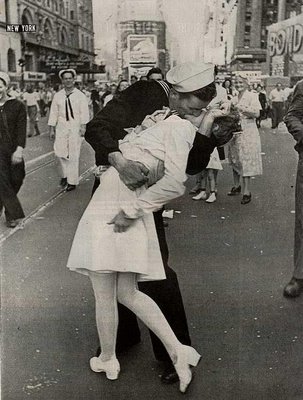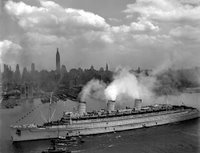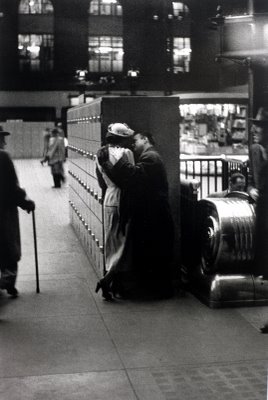Manhattan '45
 I came across a phrase a few weeks ago that really grabbed me. The phrase is simple: "the future about to occur." I Googled the phrase in quotations and discovered it's from a book called "Manhattan '45" written by Jan Morris. The book is filled with lots of eloquent descriptions about New York from that year and it's impossible to read the excerpts I've found and not feel nostalgia.
I came across a phrase a few weeks ago that really grabbed me. The phrase is simple: "the future about to occur." I Googled the phrase in quotations and discovered it's from a book called "Manhattan '45" written by Jan Morris. The book is filled with lots of eloquent descriptions about New York from that year and it's impossible to read the excerpts I've found and not feel nostalgia.Perhaps the main reason why I reacted so strongly to Morris' book was because I had been in search of a way to convey, verbally, my own experience of New York. My mission was to give non-New Yorkers some insight into what the city is like now, via my photography. But instead of simply showing them only my pictures, I wanted to get them into a "New York state of mind" and show them some classics. All of this was preparation for a talk I gave last week at Wichita State University. To make a long story short, a former workshop student of mine, Landon Taylor, who is now president of the WSU Photography Guild, recently acquired some funding from the university's Student Government Association to pay for a speaker to come to Wichita and talk to the guild. He had pitched the idea to me in March and over the past few weeks we've been planning my visit. The funding not only covered airfare, hotel accommodations and printing of publicity fliers for the talk, it also included a modest honorarium for my time and preparation. The talk was this past Friday at WSU's McKnight Art Center.
Again, what excited me the most was the opportunity to show some iconic mid-20th Century photographs of Manhattan. What came to mind immediately were pictures from the 1930s, such as the shafts of sunlight beaming down into Grand Central Station, the Rockefeller Center construction workers having lunch on a steel beam, even a shot from the original 1933 production of King Kong. From the 1950s of course there's the shot of James Dean walking in Times Square in the rain. But arguably the most famous Times Square picture, Alfred Eisenstadt's masterpiece from V-J Day of the soldier kissing the nurse, was taken on August 15, 1945. This fact conveniently coincided with the title of Morris' book. And so with her words and many, many photographs in mind, I set out to write an opening script that I would read as narration accompanying an introduction to my presentation. After ten or so minutes of that I jumped to modern-day New York, the city I moved to on a hot day in August of 2000.
Obviously, what "The Greatest Generation" had as one of its biggest New York moments is about as polar opposite from my what my generation experienced on September 11, 2001. When I think of how old I was that day, compared to the average age of most soldiers on August 15, 1945, I get a little emotional. When I think of the euphoria and relief of the war being over then, compared to the unlikelihood of a specific victory date ever being declared in this current war, I get more than a little worried. Nearly seven years after 9/11, the city is still very much haunted by that day. And to think that the United States accomplished as much as it did in the period between Pearl Harbor and V-J Day, compared to its recent involvement in Iraq since 2003, is just flat-out depressing. I have many feelings about our country's current situation in the Middle East, but none of them are as strong as my frustration that we're even there in the first place.
With this in mind, I'll leave you with some lines from Manhattan '45. She begins her book describing the Queen Mary as it entered New York Harbor in June of 1945 carrying 15,000 US soldiers, the first contingent of troops returning home from the battlefields in Europe. Victorious and well-mannered, the first thing they asked for when they disembarked was milk.
"The Manhattan skyline shimmered in the imaginations of all the nations. Its buildings stood there metal-clad, steel-ribbed, glass-shrouded, colossal and romantic—everything that America seemed to represent in a world of loss and ruin." She continues: "[New York] was not only
 bound to be, in the postwar years, the supreme and symbolical American city. All the signs were that it would be the supreme city of the Western world, or even the world as a whole...This crowded island was the head, the brain, the essence of America, and the idea of America was omnipotent then...It was the present tantalizingly sublimated. It was the Future about to occur.” Looking back from 1987, Morris writes: “The moment of grace soon passed—it lasted no more than a few years, and by the mid-1950s was fast becoming hardly more than a regretful memory. New York was never to lose its excitement, its power to move, its limitless energy; but never again, perhaps, would it possess the particular mixture of innocence and sophistication, romance and formality, generosity and self-amazement, which seems to have characterized it in those moments of triumph.”
bound to be, in the postwar years, the supreme and symbolical American city. All the signs were that it would be the supreme city of the Western world, or even the world as a whole...This crowded island was the head, the brain, the essence of America, and the idea of America was omnipotent then...It was the present tantalizingly sublimated. It was the Future about to occur.” Looking back from 1987, Morris writes: “The moment of grace soon passed—it lasted no more than a few years, and by the mid-1950s was fast becoming hardly more than a regretful memory. New York was never to lose its excitement, its power to move, its limitless energy; but never again, perhaps, would it possess the particular mixture of innocence and sophistication, romance and formality, generosity and self-amazement, which seems to have characterized it in those moments of triumph.” (Photo credits: top, Alfred Eisenstadt; middle, US Navy Photo; bottom, Louis Faurer.)
(Photo credits: top, Alfred Eisenstadt; middle, US Navy Photo; bottom, Louis Faurer.)

8 Comments:
nice post my friend. I hope the students walked away with not only a wealth of knowledge but an understanding of the depth of your love and feeling of being in NYC.
Hope al is well.
pt
Cary, I discovered your blog a few months ago and have been lurking ever since. I'm piping up finally because of your mention of one of my favorite books. It's always been my greatest fantasy to have the power to go back in time -- to the place and date of my choosing. After reading Morris' book, I knew exactly where my first visit would be.
Hope you're doing well. I'm at the Louisville paper now.
Cary, thanks for coming out last week. As always, it was good to see you and your work.
Wow. Very powerful stuff.
I attended your lecture at WSU last Friday and found it incredibly moving and thought-provoking. In particular, I love your OPP concept. Your take on New York and brief explanation of it's history really shed light on what you have captured in your own photography. Thank you so very much for coming to Wichita State and sharing your time and talents with us! I hope you'll consider a return visit someday!
Dick & I would love to have heard your speech last week....we heard it was terrific. Your photos, descriptive ability, and open emotions are painfully moving, Cary, and the world needs people like you who aren't afraid to tell it like it is. Our best to you and Y.
Love, Fran
Very Impressive! I had no idea you had it in you...Ha! 1st time I've been to this site. I'll have to come back more often. Good seeing you last week. Give our love to Yvonne.
Chad,Kelli,Emma,Claire & Isabel
o my goddess what a profound posting. i have a deep connection to the queen mary thus how i discovered your blog today. i am so thrilled to meet you and your art via your blog. congrats to you and your wife on your gorgeous baby julian. may his life be filled with grace.
Post a Comment
Subscribe to Post Comments [Atom]
<< Home